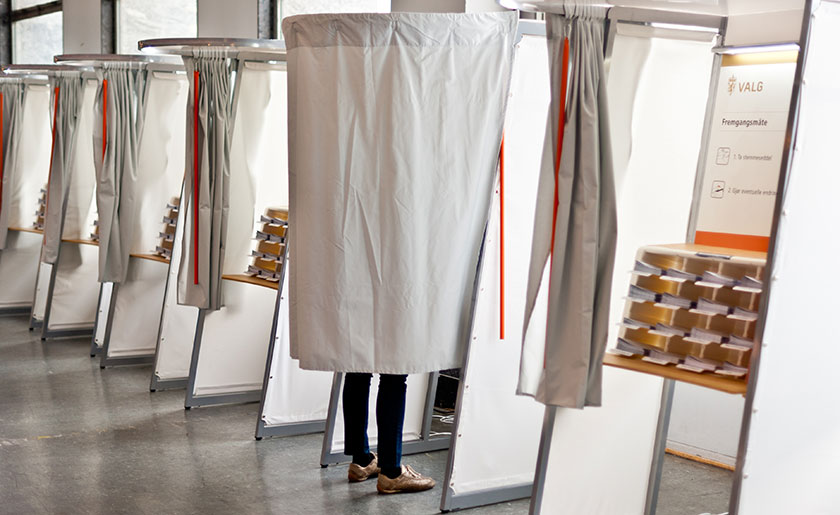
Voting booths in a Norwegian polling station. Photo: Tore Fjeld/Ministry of Local Government and Regional Development.
Parliamentary Elections in Norway
In September every fourth year, 169 Members of Parliament (MPs) from 19 constituencies are elected to the Storting. The next parliamentary election will be held on 8th September 2025.
Who can vote?
All Norwegian citizens aged 18 or older by the end of the election year in question are entitled to vote in a parliamentary election as long as they are registered on the electoral roll (the register of eligible voters).
Who can you vote for?
Almost anyone who is entitled to vote in a parliamentary election may also be elected as an MP. There are a handful of exceptions to this rule, however. For example, there are certain groups, such as civil servants in the ministries and the foreign service, and Supreme Court judges, who are not eligible for election.
Voters cast their votes on electoral lists with the names of candidates from the different political parties. It is up to the parties themselves to decide who will be on the electoral lists. These decisions are made at the parties’ nomination meetings, which will have taken place during the months leading up to the election.
How do you vote?
Voting itself may be conducted in one of two ways. Voters can either meet up in person at one of the polling stations on election day, or they can vote in advance. It is up to voters themselves to decide which of these two methods to choose.
The majority of voters still opt to cast their votes on election day, which – the law states – must be a Monday in September. It is the sitting Government’s responsibility to determine the exact date. Municipal councils may also decide to open up for voting on the day before election day in one or more of their local polling stations.
When voting in person, voters turn up at one of the polling stations in the municipality where they are registered. They must produce a valid ID so that the election official can verify their identity and cross off their name on the electoral roll. This is to prevent the same person from being able to vote more than once.
Voters go into one of the voting booths, where the different electoral lists are laid out. They select the list they wish to vote for, fold it in two, give it to the election official to stamp, and then put it in the sealed ballot box themselves. This procedure is designed to ensure that voting is free and secret.
Until the current parliamentary election, it was possible for voters to make changes in the electoral lists by crossing out or giving extra votes to individual candidates. However, the recently-amended Election Act, which came into force in May 2024, stipulates that such changes are no longer possible in parliamentary elections. From now on, such changes will only be permitted in local government elections.
The election results
The Norwegian electoral system is based on the principle of proportional representation in multi-member constituencies. This means that the number of seats (and, therefore, MPs) won by a party is, as far as possible, directly proportionate to the amount of support the party has among the voters.
Norway is divided into 19 constituencies (or electoral districts). These correspond to the old county borders which existed before the recent local government reforms. The total number of seats in the Storting allocated to each constituency is based on the size of the population in that constituency. In addition, a further calculation is used which combines population with area to make sure that sparsely populated constituencies are also adequately represented. In total, 169 MPs are elected to the Storting.
Since votes are counted and results settled in each individual constituency, the electoral system can give a “skewed” distribution of parliamentary seats among the parties. For example, when 4 seats in a constituency are to be divided among 7 parties, it is not possible to achieve a distribution of seats which precisely reflects the number of votes given to each party. This may lead to several parties ending up without representation. The method of calculation itself also reinforces the distorted distribution, with larger parties tending to be 'overrepresented' and smaller parties 'underrepresented' relative to their share of the vote.
To correct this, Norway makes use of a system of seats at large. Seats at large are allocated to parties that have received fewer MPs than they should have in relation to their share of the national vote after the first 150 seats have been distributed. There are a total of 19 seats at large, corresponding to one in each constituency. Parties receive seats at large in the constituencies where they were closest to winning a seat. This system brings the composition of the Storting closer in line with each party’s share of the vote nationwide. However, only parties that have passed the minimum threshold of 4 percent of the national vote are eligible to compete for seats at large. There is no minimum threshold for the distribution of constituency seats.
Last updated: 22.08.2025 12:52